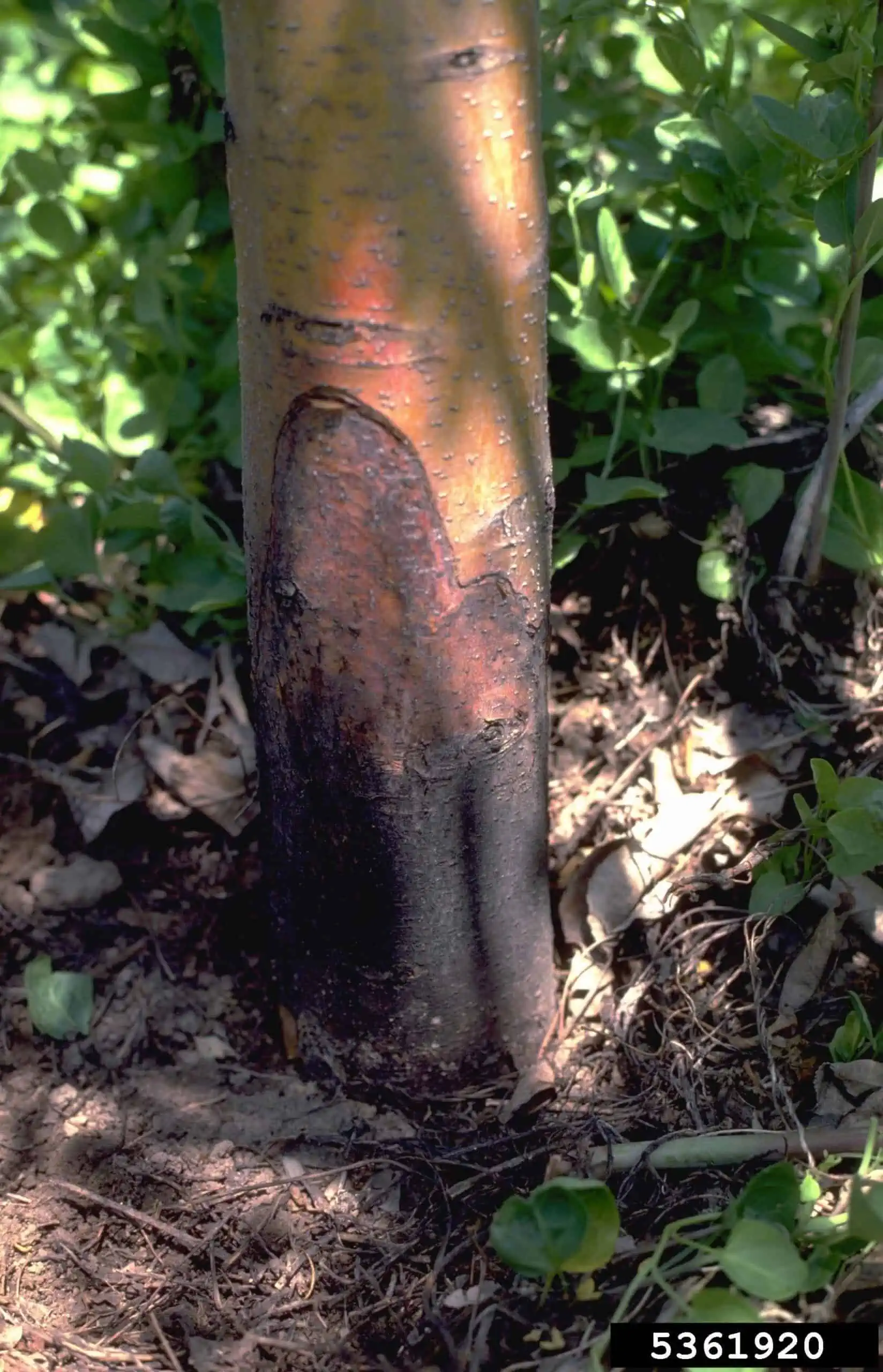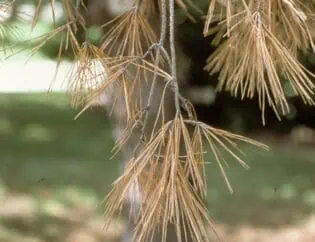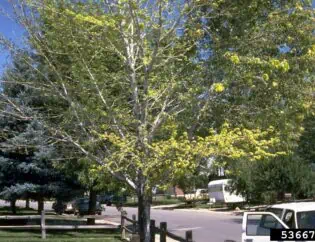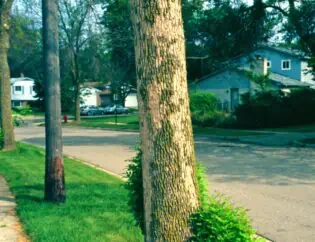
When you spot symptoms like wilting or yellowed leaves, it’s crucial to acknowledge the shared responsibility we have to protect our leafy kin. By understanding this tree disease and taking prompt action, you’re not just caring for a plant but preserving a cherished member of your garden community.
Let’s explore how you can identify, treat, and prevent Phytophthora Root Rot, ensuring that your trees remain healthy and strong, just like the bonds that connect us to nature.
When confronted with advanced stages of Phytophthora root rot, it may become necessary to consider tree removal as a last resort to prevent further disease spread and ensure the health of your garden.
Recognizing Phytophthora Symptoms
Phytophthora root rot is a troublesome problem for many plants, not just trees. It’s caused by a water mold, which is a type of microorganism acting as a pathogen. This disease can affect a wide range of plants in various geographical areas.
How can you tell if your tree is suffering from Phytophthora root rot? You’re part of a community that nurtures and values the health of trees, and recognizing symptom patterns is vital.
Look for leaves that appear drought-stressed, or a canopy that’s thinning with yellow or reddish hues or a soft area on the trunk near to the ground—these are cries for help. Different tree species may show varying levels of susceptibility, with young trees often at greater risk.
Early detection techniques, like careful examination of the roots and crowns for soft, brown tissue, are essential. Be aware, the long term effects on soil health can be profound, as the pathogen lingers.
To protect your trees, adopt integrated pest management strategies that emphasize prevention and sustainable practices.
Understanding PRR Biology
Recognizing the symptoms of Phytophthora root rot, you’ll find that understanding its biology is key to effectively managing this pervasive pathogen. As you delve into Phytophthora research, you’ll discover that this organism’s life cycle is complex, involving motile spores that target vulnerable roots.
The infection mechanisms are sophisticated; zoospores encyst and adhere to the root surface, penetrating plant tissues and causing devastating damage.
To stand united against this threat, it’s essential to adopt Phytophthora control methods that focus on preventing spore germination and spread. By implementing informed Phytophthora management strategies, you’re not just protecting your trees; you’re joining a community dedicated to nurturing healthy, resilient ecosystems.
Together, we can mitigate the impact of this challenging disease.
Essential Phytophthora Water Management Practices
Consistently managing water effectively is your best defense against Phytophthora root rot in trees. To protect your cherished green companions, start with phytophthora water treatment. While treatments like UV or chlorination to purify your water sources are typically more relevant for large-scale agricultural operations, ensuring the use of clean, uncontaminated water for irrigation is crucial.
Prioritize soil compaction prevention; it’s key to ensuring proper drainage and averting waterlogged conditions that invite Phytophthora.
Embrace resistant plant selection as a part of your community. Choose trees known for their resilience to root rot, fostering a robust landscape.
Rigorously practice plant material sanitation, cleaning tools and avoiding the spread of disease.
Lastly, integrate these practices into a broader integrated tree pest management strategy and keep informed by reading additional PRR resources.
Landscape Modification for Phytophthora Pathogen Prevention
To prevent Phytophthora root rot in your landscape, consider implementing several key modifications to the terrain and planting practices. It’s all about creating a community of plants that support each other in a healthy environment. Here are some strategies to make your garden a safe haven:
- Ensure proper drainage to avoid soil saturation, such as creating raised beds or slopes.
- Apply mulching techniques with composted bark to enrich soil and reduce splash dispersal.
- Explore alternative planting options that are less susceptible to Phytophthora.
- Use ground covers that prevent puddling and protect your plants’ roots.
These steps will guide you in nurturing a more resilient garden.
Proper Tree Planting Techniques for Phytophthora Prevention
You’ll ensure your tree’s best defense against Phytophthora root rot by mastering proper planting techniques that promote healthy growth and effective drainage.
Begin by selecting certified nursery stock, which is less likely to carry the pathogen. Choose phytophthora resistant rootstocks, especially if you’re planting in an area with a history of the disease.
Prepare the site with thorough soil fumigation to minimize existing spores before planting. When you plant, make sure the graft union is well above the soil line to prevent moisture buildup.
Your vigilance doesn’t end after planting—practice proper irrigation, avoiding overwatering and ensuring water doesn’t pool around the base. Remember, early detection can save your tree; keep an eye out for symptoms and act swiftly if you suspect trouble.
Diagnosing Phytophthora Infected Trees
As you transition from planting to tree care, accurately diagnosing Phytophthora root rot is essential for your tree’s health and longevity. Early detection of Phytophthora can save your beloved trees and prevent the spread to others in your community’s green space.
Here’s how you can identify the signs and join the effort in protecting our trees:
- Watch for symptoms such as leaf wilt, discoloration, and dieback.
- Inspect for darkened bark at the soil line, a telltale sign of crown rot.
- Check for proper drainage; standing water is a red flag.
- Employ an ALERT LF™ test for a quick, in-field confirmation.
Phytophthora Treatment Strategies
- Fungicide Application:
- Progressive Tree Service, as a certified arborist, can apply fungicides specifically labeled for Phytophthora species. The choice of fungicide will depend on the tree species and the specific Phytophthora pathogen.
- Soil drenches or trunk injections are common methods of applying fungicides. Soil drenches involve applying the fungicide to the soil around the base of the tree, allowing it to be absorbed by the roots. Trunk injections directly introduce the fungicide into the tree’s vascular system.
- Multiple applications may be necessary, as Phytophthora can persist in the soil and re-infect the tree.
- Pruning Infected Parts:
- Prune away visibly diseased parts of the tree, such as branches with dieback or leaves showing signs of infection.
- It’s crucial to sterilize pruning tools before and after use to prevent spreading the disease to healthy parts of the tree or other plants.
- Improving Soil Drainage:
- While this doesn’t cure the infected tree, improving soil drainage can help reduce the severity of the infection and prevent further damage. This includes aerating the soil and ensuring that water does not accumulate around the base of the tree.
- Reducing Stress on the Tree:
- Ensure the tree is not stressed by other factors, such as drought or nutrient deficiencies. Proper watering (avoiding overwatering) and fertilization can help the tree better cope with the infection.
- Consultation with a Professional Arborist:
- Given the complexity of Phytophthora root rot treatment, consulting with a professional arborist like Progressive Tree Service is highly recommended. They can provide specific advice based on the tree species, the extent of the infection, and local environmental conditions.
- Regular Monitoring:
- After treatment, it’s important to regularly monitor the tree for signs of recovery or further decline. This will help in determining if additional treatments or actions are needed.
Reporting the Infection
- Local Agricultural Extension Services: In some areas, reporting the infection to local agricultural extension services or environmental authorities is recommended or required. They can offer additional advice and may need to track the spread of the disease.
Important Considerations
- Tree Removal: In severe cases where the tree is extensively damaged and poses a risk of falling or spreading the disease, removal might be the only viable option.
- Preventive Measures for Surrounding Trees: Implement preventive measures for nearby trees to protect them from infection.
Implementing Additional Control Measures
Implementing additional control measures can further protect your trees from the devastating effects of Phytophthora root rot. You’re not alone in this fight; join a community of tree enthusiasts implementing these tried-and-true strategies:
- Sanitation measures: Maintain hygiene by cleaning tools and avoiding the spread of infected soil.
- Stock certification: Always opt for certified, disease-free planting stock to ensure a healthy start.
- High temperatures control: While steam or solarization to sterilize soils and equipment is more applicable in controlled environments like greenhouses or nurseries, maintaining clean and sterilized equipment is crucial.
- Fertilizing regimes: Adjust your approach to fertilizing, using techniques that specifically counteract Phytophthora.
Utilizing Resources and Expertise
You’ll find invaluable guidance by tapping into the expertise and resources provided by local Cooperative Extension offices. These trusted allies are your go-to for preventing and managing Phytophthora presence, which is a cornerstone in protecting your cherished trees.
Embracing the importance of early detection in Phytophthora management can save not just individual trees, but entire landscapes from devastation.
Learn about the role of mulching in preventing Phytophthora infection and how integrated pest management for Phytophthora control can be a game-changer for your green sanctuaries.
With the impact of climate change on Phytophthora spread, it’s more crucial than ever to stay informed and proactive. You’re not alone in this fight—community knowledge and support are your best allies.
*
Phytophthora image by
H.J. Larsen, Bugwood.org
we are not affiliated with bugwood.org


